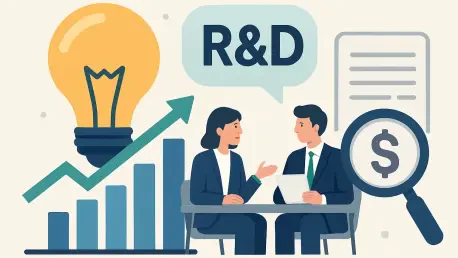In an era where corporate innovation drives economic progress, the question of whether financial markets can accurately assess the value of research and development (R&D) and inventive output remains critical for investors and analysts alike. As companies pour significant resources into R&D to stay competitive, the stakes are high to determine if stock prices reflect the future benefits of these investments or if mispricing creates hidden opportunities. Drawing on a detailed study by Amit Goyal and Sunil Wahal titled “R&D, Innovation, and the Stock Market” from April 2024, this exploration unravels the complex relationship between innovation metrics—such as R&D spending and the Economic Value of Patents (EVP)—and market valuation. It examines whether markets efficiently incorporate the long-term benefits of innovation or if persistent discrepancies arise from flawed financial frameworks, offering key insights into a rapidly evolving economic landscape.
The significance of innovation cannot be overstated, especially as historical data reveals a dramatic rise in R&D intensity over nearly five decades, with aggregate R&D-to-book equity ratios climbing from a modest 3.2% to a striking 10.1% by 2022. Large corporations, commanding 88% of total R&D expenditure and patent issuance, stand at the forefront of this shift toward knowledge-driven industries. Yet, the central challenge remains: do stock markets adequately recognize the enduring value of these efforts, or do they struggle to translate inventive potential into accurate pricing? This analysis aims to shed light on the nuanced dynamics at play, from profitability predictions to market efficiency debates, providing a comprehensive view of how innovation shapes financial outcomes.
Understanding the Innovation-Market Nexus
Innovation as a Driver of Economic Value
R&D Spending on the Rise
The transformation of modern economies into knowledge-centric powerhouses is evident in the staggering growth of R&D investment over the past several decades. By 2022, the ratio of R&D spending to book equity had surged to over 10%, a clear indicator of how integral innovation has become to corporate strategy. Large firms, in particular, dominate this space, accounting for the lion’s share of expenditure and patent activity while representing a significant portion of market capitalization. This trend highlights a broader shift where intellectual capital increasingly dictates competitive advantage, pushing companies to prioritize innovation as a core driver of value. For investors, this raises critical considerations about whether the market can keep pace with such rapid changes, accurately reflecting the future benefits of these substantial investments in stock valuations or leaving gaps that savvy players might exploit.
Profitability Predictions in Large Firms
Focusing on large-cap stocks, a compelling link emerges between innovation efforts and future financial success, as evidenced by the predictive power of R&D spending and EVP. These metrics forecast cash profitability over a decade-long horizon, even when traditional indicators like past earnings are factored in. This suggests that for major corporations, innovation acts as a robust engine for sustained earnings growth, directly influencing how their stock prices should be shaped by forward-looking expectations. Unlike smaller counterparts, these firms possess the resources and infrastructure to convert inventive inputs into measurable outcomes, reinforcing their market dominance. The implication for market participants is clear: large firms with strong R&D programs may offer a more reliable bet for capturing the economic value of innovation, provided pricing mechanisms account for these long-term profitability trends.
Disparities Across Firm Sizes
Challenges for Smaller Companies
While large firms reap the rewards of innovation, small-cap stocks face a strikingly different reality, with no discernible connection between R&D efforts or EVP and future profitability. Despite often being viewed as agile innovators, smaller companies struggle to translate their inventive activities into consistent financial gains, a disparity that poses unique risks for investors seeking high-growth opportunities. This lack of correlation may stem from limited resources, weaker market positioning, or the inability to scale R&D outcomes effectively, leaving their stock prices disconnected from innovation potential. For market analysts, this underscores a critical divide: betting on small firms for innovation-driven returns carries significant uncertainty, as their efforts frequently fail to materialize into the earnings growth that markets might otherwise anticipate.
No Link to Asset Expansion
Another unexpected finding is the absence of a relationship between innovation and future asset growth across all firm sizes, challenging the assumption that R&D naturally fuels broader business expansion. Unlike the clear impact on profitability seen in large firms, neither R&D spending nor patent value appears to drive increases in physical or financial assets, suggesting that innovation’s primary economic contribution lies in enhancing earning capacity rather than tangible growth. This insight shifts the narrative around how innovation influences firm value, indicating that markets should prioritize earnings potential over expectations of asset accumulation when pricing inventive firms. For investors, this means recalibrating strategies to focus on profitability metrics rather than growth indicators, as the latter may not reflect the true impact of a company’s innovation endeavors.
Market Efficiency and Mispricing Debates
Testing Market Efficiency
Early Signs of Undervaluation
Initial assessments using established financial frameworks, such as Zhang’s q-factor model and Fama-French’s five-factor model, reveal intriguing hints of mispricing in the market’s handling of innovation. High R&D large stocks exhibit positive alphas, suggesting annualized excess returns that could indicate undervaluation of their inventive efforts. At first glance, this points to a potential market inefficiency, where stock prices fail to fully capture the future benefits of robust R&D programs, creating opportunities for investors to capitalize on overlooked value. Such findings fuel ongoing debates among academics and practitioners about whether markets systematically underprice intangible assets like innovation, prompting a closer examination of whether these anomalies represent true inefficiencies or merely artifacts of the analytical tools employed.
Corrected Metrics Show Accuracy
Upon deeper scrutiny, the apparent mispricing of high R&D stocks dissolves when cash profitability is adopted as the key metric instead of gross profitability or other traditional measures. This adjustment eliminates the positive alphas previously observed, revealing that the market does not inherently undervalue innovation but rather suffers from inadequate model specifications in standard factor analyses. The shift to cash-based metrics aligns stock pricing more closely with the actual economic impact of R&D, suggesting that markets are more efficient than initial tests imply. This finding challenges the popular narrative of widespread mispricing, indicating that the fault lies with outdated or ill-suited financial models rather than a fundamental failure of market mechanisms to account for the value of innovation over extended periods.
Refining Financial Models
Flaws in Traditional Frameworks
A closer look at traditional factor models uncovers significant shortcomings in their ability to capture the unique profitability dynamics of firms heavily invested in R&D. Issues such as counterintuitive factor loadings—where high R&D firms show negative returns on equity despite strong earnings—highlight how these models often misrepresent the financial health of innovative companies. Additionally, the standard treatment of R&D as an immediate expense rather than a capitalized asset distorts profitability measures, leading to skewed valuations. This methodological gap underscores the need for updated approaches that better reflect the economic realities of knowledge-driven businesses, ensuring that market pricing aligns with the true value generated by sustained innovation efforts over time.
Embracing Patient Capital
The long-term nature of innovation returns further complicates market valuation, as the benefits of R&D and EVP often unfold over a decade, with delays such as the average two-year lag between patent application and grant adding to the timeline. This extended horizon necessitates a shift toward patient capital, where investors and firms alike adopt strategies that prioritize enduring value over short-term gains. Financial models must also evolve to incorporate these prolonged timelines, using refined metrics like cash profitability and adjusted R&D accounting to provide a clearer picture of innovation’s impact. For market participants, this emphasizes the importance of long-term investment perspectives and the adoption of analytical tools that account for the gradual realization of returns, ensuring that the pricing of innovative firms reflects their full potential rather than fleeting snapshots of performance.









